3D Imaging Market: Size, Share, Trends & Forecast (2024-2029)
The report covers a comprehensive analysis segmented By Component (Hardware, Software, Services), By Organization (MSME, Large Enterprises), By Technology (Vile Access Device, Male Luer, Bag Spike, Female Component), By Deployment (On-Premises, Cloud) By Geography (North America, South America, Asia Pacific, Europe, the Middle East, Africa).
3D Imaging Market Snapshot
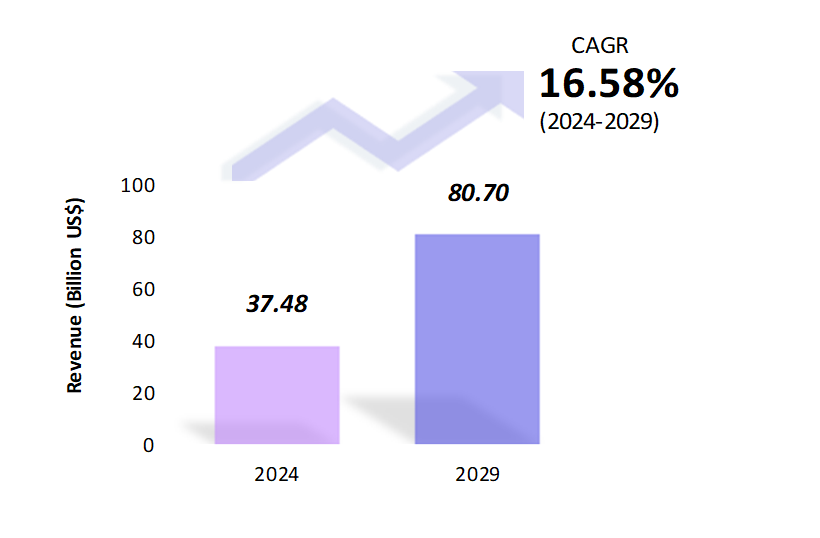
3D Imaging Market Overview
The market for 3D imaging is expected to grow from its estimated $37.48 billion in 2024 to $80.70 billion in 2029. The market for 3D imaging is expected to grow at a compound annual growth rate (CAGR) of 16.58% between 2024 and 2029. The 3D imaging market has witnessed significant growth and diversification in recent years, driven by advancements in technology and increasing demand across various industries. This market encompasses a wide range of applications, including medical imaging, entertainment, industrial metrology, architecture, and automotive. In the medical sector, 3D imaging techniques such as CT scans, MRIs, and ultrasounds have revolutionized diagnostics and treatment planning, enabling healthcare professionals to visualize internal structures with unprecedented detail and accuracy. Similarly, in entertainment and gaming, 3D imaging technologies have transformed user experiences, offering immersive virtual environments and lifelike characters. Industries like manufacturing and construction rely heavily on 3D imaging for quality control, product design, and prototyping. High-precision 3D scanners and metrology systems allow for precise measurement and inspection of components, ensuring compliance with strict industry standards. Additionally, the automotive sector has embraced 3D imaging for applications such as advanced driver assistance systems (ADAS), autonomous vehicle navigation, and virtual simulations for vehicle design and testing. The market for 3D imaging is also driven by the increasing adoption of augmented reality and virtual reality technologies. These immersive technologies leverage 3D imaging to create realistic simulations and interactive experiences in fields like gaming, education, training, and marketing. Nevertheless, ongoing advancements in technology, coupled with efforts to address these challenges through collaboration, research, and standardization, are expected to fuel further growth in the 3D imaging market. With applications continuing to expand across diverse industries and new innovations driving the development of more accessible and user-friendly solutions, the future outlook for the 3D imaging market remains promising.
3D Imaging Market Coverage
| Historical & Forecast Period | 2018-2029 |
| Base Year | 2023 |
| Forecast Period | 2024-2029 |
| Units | Billion US$ |
| Segments | Component, Organization, End User |
| Geographies | North America, South America, Asia Pacific, Europe, the Middle East, Africa |
| Key Vendors |
GE HealthCare Technologies Inc., Kitware, Inc., Autodesk Inc., Adobe Inc., Mindray Medical International Ltd. |
Key Geographies of 3D Imaging Market, 2023
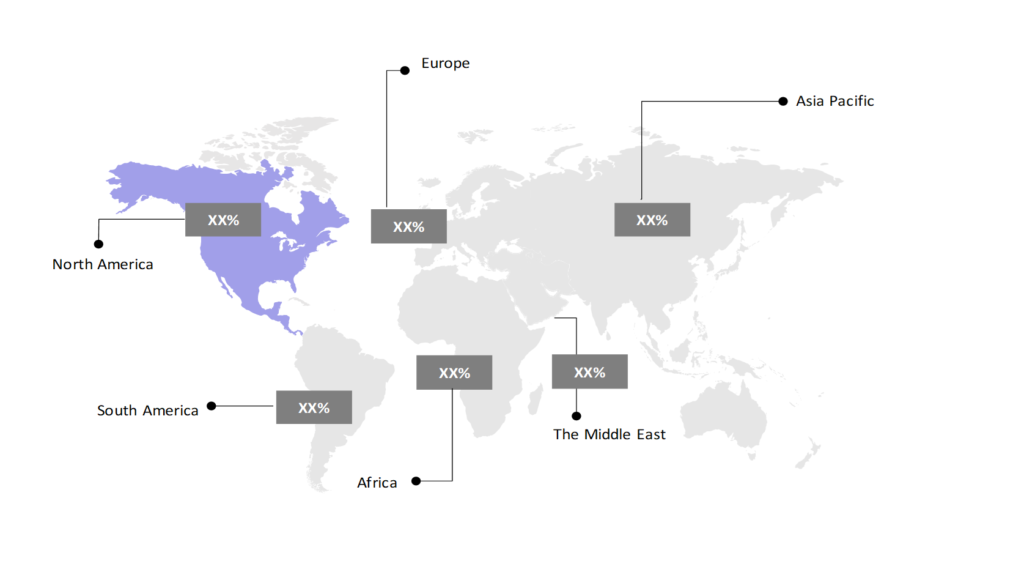
Porter’s 5 Forces Analysis of 3D Imaging Market
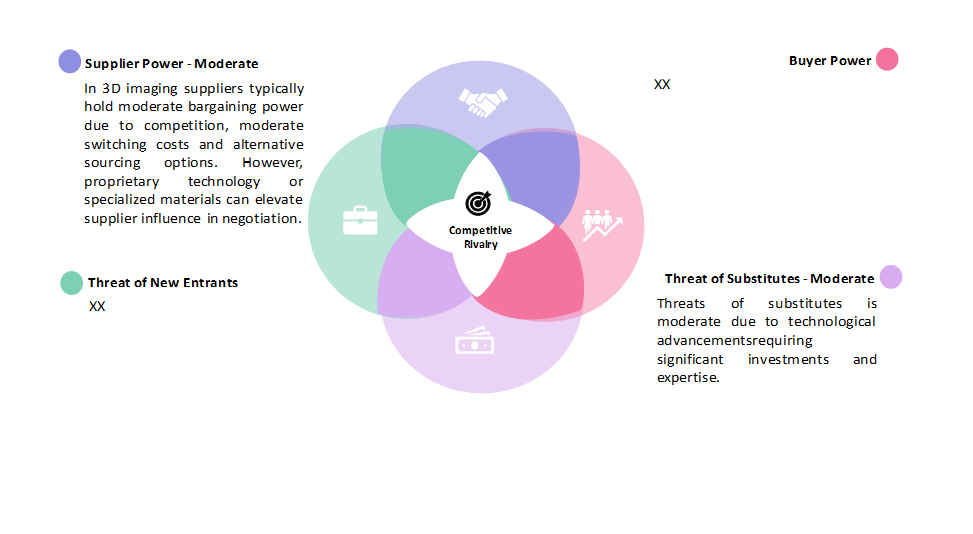
3D Imaging Market Trends
The 3D imaging market is witnessing sturdy growth and transformation fueled by technological innovations and expanding applications across industries. In healthcare, advanced imaging technologies like MRI, CT scans, and 3D ultrasound are revolutionizing diagnostics, surgical planning, and patient care, leading to more accurate diagnoses and personalized treatments. (AR) Augmented Reality and (VR) Virtual Reality are increasingly integrated with 3D imaging, reshaping sectors such as gaming, entertainment, education, and training with immersive experiences and realistic visualizations. Automotive industries use 3D imaging for design, manufacturing, and quality control, enhancing vehicle safety and performance through precise measurements and object detection. Consumer electronics are integrating 3D imaging features, such as facial recognition in smartphones, to offer enhanced user experiences and augmented reality applications, driving market adoption. Industrial sectors benefit from 3D imaging for precision measurement, quality control, and process optimization, accelerating product development cycles and reducing errors. The constructive interaction between 3D imaging and additive manufacturing technologies is fostering innovation in product design and prototyping, enabling customized solutions and rapid production. Governments and urban planners leverage 3D imaging for smart city development, supporting urban design simulations, infrastructure planning, and environmental monitoring with accurate spatial analysis tools. Security and surveillance applications deploy 3D imaging for facial recognition, object tracking, and perimeter monitoring, enhancing real-time situational awareness and threat detection in various settings. These trends underscore the increasing significance of 3D imaging across diverse sectors, impelled by its ability to provide detailed spatial information, enhance visualization capabilities, and enable innovative applications that transform industries and society. (AI) Artificial Intelligence plays a crucial role in enhancing 3D imaging technologies across various domains. Examples include- In medical imaging, AI algorithms can assist in tasks like segmentation of organs and tissues from 3D scans, aiding in diagnosis and treatment planning. In autonomous vehicles, AI enables real-time analysis of 3D data from LiDAR or camera sensors, helping vehicles perceive and navigate their surroundings accurately.
3D Imaging Market Driving Factors
In 3D imaging, drivers consist of different technologies, methods, and uses that push the field forward. In the domain of 3D imaging, advancements in hardware technologies have been pivotal for its progress. Innovations in sensor technology, notably time-of-flight (ToF) cameras and structured light systems, have significantly improved the precision and speed of capturing three-dimensional data. These sophisticated sensors enable more accurate depth perception and faster image acquisition, laying the foundation for various applications ranging from virtual reality to industrial metrology. Improvements in optics and image processing hardware have led to better image quality and higher resolutions. Software drivers, like algorithms for image reconstruction, depth estimation, and object recognition, are also important. They are always getting better, especially with machine learning and computer vision techniques. These advancements help create more accurate 3D reconstructions from diverse types of data. Furthermore, the incorporation of 3D imaging into various fields such as medical imaging, autonomous vehicles, and augmented reality has been instrumental in driving advancements. This integration has sparked interdisciplinary research and innovation, fueling the rapid evolution and adoption of 3D imaging technologies. The synergy between hardware enhancements, like sensor technology, and software developments, such as advanced algorithms, alongside the diverse applications of 3D imaging, reinforces its significance in shaping future technological landscapes.
3D Imaging Market Challenges
Excessive costs are a major hurdle for the widespread adoption of advanced 3D imaging technologies in various industries. These costs encompass both hardware components, like specialized sensors and cameras, and software development and implementation. Such expenses can be particularly burdensome for small and medium-sized businesses, hindering their access to 3D imaging solutions. Moreover, interoperability issues between different 3D imaging systems and software platforms create additional obstacles, as seamless integration is vital for optimizing the use of 3D imaging across different workflows and applications. The complexity of processing and analyzing large volumes of 3D data poses a significant challenge, necessitating considerable computational resources and expertise in data handling and interpretation. This complexity extends to data storage and management, especially in industries such as healthcare and manufacturing. Here, extensive amounts of 3D imaging data are produced, requiring secure storage while remaining easily accessible for analysis and decision-making purposes. Regulatory and privacy concerns, particularly in fields like healthcare, create hurdles for widespread 3D imaging technology adoption. It is crucial to comply with data protection rules and address ethical concerns to build trust. Overcoming these obstacles needs collaboration, investment in research, and setting standards to support market growth while addressing cost, interoperability, data management, and regulatory issues.
3D Imaging Market – Key Industry News
- In March 2024, MedUni Vienna and TU Wien have collaborated on a project to create the world’s inaugural 3D-printed “brain phantom,” replicating brain fiber structure, and suitable for imaging via a specialized variant of magnetic resonance imaging (dMRI). This innovation aids in studying neurodegenerative diseases like Alzheimer’s, Parkinson’s, and multiple sclerosis.
- In June 2023, GE HealthCare Inc. and DePuy Synthes, the Orthopedics Company of Johnson & Johnson, have formed a distribution agreement to extend the reach of GE HealthCare’s OEC 3D Imaging System alongside DePuy Synthes’ product range to surgeons and patients throughout the United States. This partnership underscores GE HealthCare’s dedication to delivering advanced imaging solutions for complex spine procedures in healthcare.
- In Jan 2024, Activ Surgical, a pioneer in digital surgery, completed its first international surgery at Abdali Hospital in Amman, Jordan. They used ActivSight™ Intelligent Light, which enhances visualization and provides real-time surgical insights.
3D Imaging Market Competitive Landscape
The competitive landscape within the 3D imaging sector is characterized by a dynamic environment driven by innovation and technological advancements. Companies within this space continuously strive to differentiate themselves through product offerings, technological expertise, and market positioning. Key factors influencing competitiveness include product quality, reliability, cost-effectiveness, and the ability to meet evolving customer demands. Additionally, partnerships and collaborations play a significant role in enhancing competitiveness by leveraging complementary strengths and expanding market reach. Regulatory compliance and adherence to industry standards also contribute to maintaining a competitive edge. Several important entities in the 3D imaging market include GE HealthCare Technologies Inc., Kitware, Inc., Autodesk Inc., Adobe Inc., Mindray Medical International Ltd., and others.
3D Imaging Market Company Share Analysis, 2023 (%)
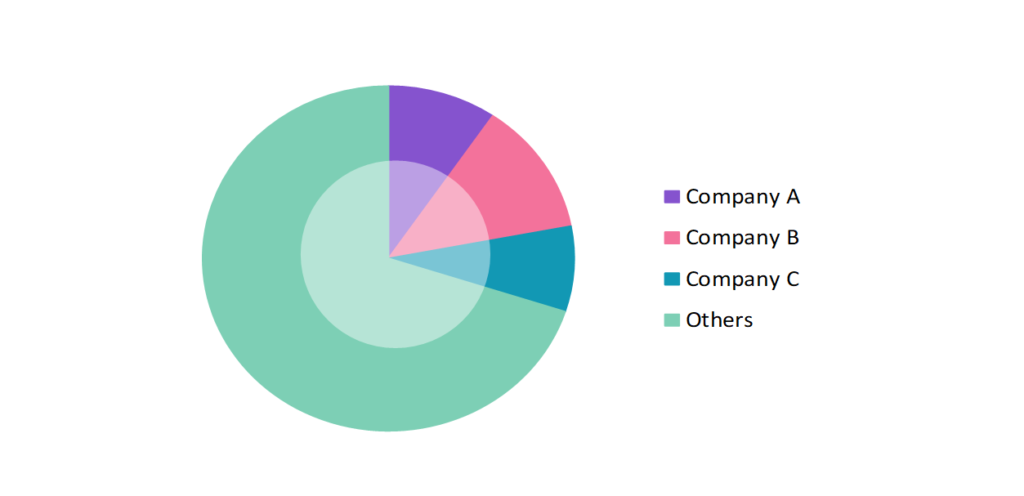
3D Imaging Market – Key Companies
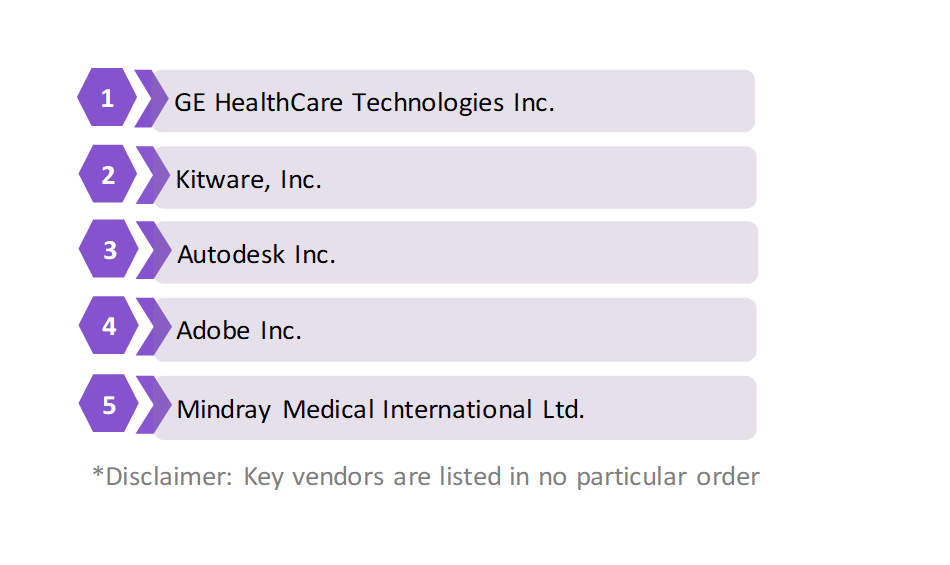
Reason to Buy from us

Table of Contents
| 1. Introduction |
|---|
| 1.1. Research Methodology |
| 1.2. Scope of the Study |
| 2. Market Overview / Executive Summary |
| 2.1. Global 3D Imaging Market (2018 – 2022) |
| 2.2. Global 3D Imaging Market (2023 – 2029) |
| 3. Market Segmentation |
| 3.1. Global 3D Imaging Market by Component |
| 3.1.1. Hardware |
| 3.1.2. Software |
| 3.1.3. Services |
| 3.2. Global 3D Imaging Market by Organisation |
| 3.2.1. MSME |
| 3.2.2. Large enterprises |
| 4. Regional Segmentation |
| 4.1. North America |
| 4.1.1. The U.S |
| 4.1.2. Canada |
| 4.1.3. Mexico |
| 4.2. South America |
| 4.2.1. Brazil |
| 4.2.2. Argentina |
| 4.2.3. Colombia |
| 4.2.4. Chile |
| 4.2.5. Rest of South America |
| 4.3. Asia Pacific |
| 4.3.1. China |
| 4.3.2. India |
| 4.3.3. Japan |
| 4.3.4. South Korea |
| 4.3.5. Rest of Asia Pacific |
| 4.4. Europe |
| 4.4.1. UK |
| 4.4.2. Germany |
| 4.4.3. Italy |
| 4.4.4. France |
| 4.4.5. Spain |
| 4.4.6. Rest of Europe |
| 4.5. The Middle East |
| 4.5.1. Turkey |
| 4.5.2. UAE |
| 4.5.3. Saudi Arabia |
| 4.5.4. Rest of the Middle East |
| 4.6. Africa |
| 4.6.1. Egypt |
| 4.6.2. South Africa |
| 4.6.3. Rest of Africa |
| 5. Value Chain Analysis of the Global 3D Imaging Market |
| 6. Porter Five Forces Analysis |
| 6.1. Threats of New Entrants |
| 6.2. Threats of Substitutes |
| 6.3. Bargaining Power of Buyers |
| 6.4. Bargaining Power of Suppliers |
| 6.5. Competition in the Industry |
| 7. Trends, Drivers and Challenges Analysis |
| 7.1. Market Trends |
| 7.1.1. Market Trend 1 |
| 7.1.2. Market Trend 2 |
| 7.1.3. Market Trend 3 |
| 7.1.4. Market Trend 4 |
| 7.1.5. Market Trend 5 |
| 7.2. Market Drivers |
| 7.2.1. Market Driver 1 |
| 7.2.2. Market Driver 2 |
| 7.2.3. Market Driver 3 |
| 7.2.4. Market Driver 4 |
| 7.2.5. Market Driver 5 |
| 7.3. Market Challenges |
| 7.3.1. Market Challenge 1 |
| 7.3.2. Market Challenge 2 |
| 7.3.3. Market Challenge 3 |
| 7.3.4. Market Challenge 4 |
| 7.3.5. Market Challenge 5 |
| 8. Regulatory Landscape |
| 9. Competitive Landscape |
| 9.1. GE Healthcare Inc. |
| 9.2. Kitware, Inc. |
| 9.3. Autodesk Inc. |
| 9.4. Adobe Inc. |
| 9.5. Mindray medical international Ltd. |
| 9.6. Company 6 |
| 9.7. Company 7 |
| 9.8. Company 8 |
| 9.9. Company 9 |
| 9.10. Company 10 |
3D Imaging Market – Frequently Asked Questions (FAQs)
What is the current size of the global 3d imaging market?
The market size for the global 3d imaging market in 2024 is $37.48 Bn.
Who are the major vendors in the global 3d imaging market?
The major vendors in the global 3d imaging market are GE HealthCare Technologies Inc., Kitware, Inc., Autodesk Inc., Adobe Inc., Mindray Medical International Ltd.
Which segments are covered under the global 3d imaging market segments analysis?
This report offers in-depth insights into each type, material, application, end user.
